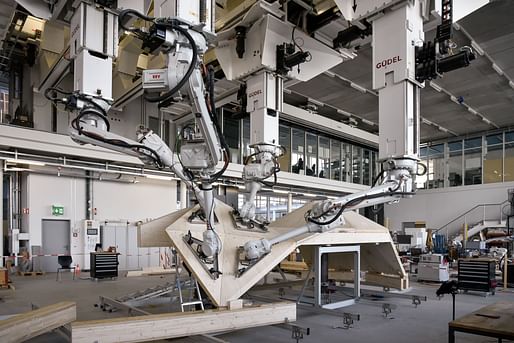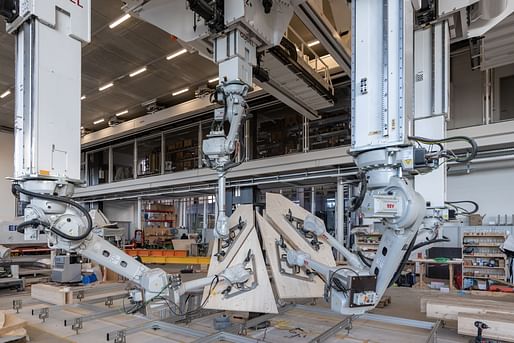
Researchers at ETH Zurich in Switzerland have offered an insight into the design and fabrication of a new architectural sculpture, built with the help of artificial intelligence and four robots. The structure, standing 22.5 meters (74 feet) in height, will consist of five geometrically-complex wooden pods all slightly offset from each other and supported by eight thin steel pillars.

Titled "Semiramis" after the Babylonian queen associated in folklore with the Hanging Gardens of Babylon, the sculpture is currently being manufactured at ETH Zurich’s Robotic Fabrication Laboratory. In what the team describes as a “delicate dance for the highest precision,” the wooden pods are being assembled by four suspended robotic arms, each collecting wooden panels and placing them in accordance with a computer-generated design.

Once the robotic arms have placed four panels next to each other, craftspeople bond the elements using a special casting resin. When the final sculpture is unveiled at the Tech Cluster Zug in the summer of 2022, its five pods will each comprise between 51 and 88 wooden panels, all containing assortments of planting and greenery.

The structure was designed in collaboration with Zurich-based Müller Illien Landscape Architects and Swiss timber construction engineers Timbatec, using innovative digital methods for both its design and delivery.
While traditional design approaches would see a single initial design proposal steadily growing over time in response to various functional requirements, the team behind the hanging garden sculpture used a machine-learning algorithm to generate a range of sophisticated design options from the project's beginning. Each AI-generated proposal offered a unique approach to the arrangement of the hanging pods, highlighting how each variation would impact functional requirements such as irrigation.

Preferred proposals were further explored within ETH Zurich’s Immersive Design Lab, where researchers examined the designs in three dimensions. The team was able to easily adapt their preferred proposal using computational robotic software, whereby a pod could continually resolve its own geometry and structural requirements as researchers moved and reconfigured any one of the pod’s 70 wooden panels.
“The computer model lets us reverse the conventional design process and explore the full design scope for a project,” explained Matthias Kohler, Professor of Architecture and Digital Fabrication at ETH Zurich. “This leads to new, often surprising geometries.”
News of the sculpture comes shortly after ETH Zurich unveiled HiLo, a research building on the institute’s Duebendorf campus featuring a doubly curved concrete roof, lightweight funicular floors, and self-learning building technology. The institute was also recently involved in the creation of the world’s first 3D-printed concrete footbridge built without any reinforcement, which was showcased at the 2021 Venice Architecture Biennale.
Video via ETH Zürich on YouTube
No Comments
Block this user
Are you sure you want to block this user and hide all related comments throughout the site?
Archinect
This is your first comment on Archinect. Your comment will be visible once approved.